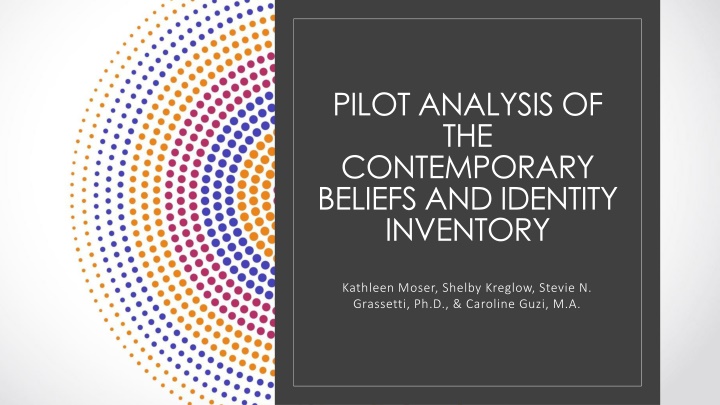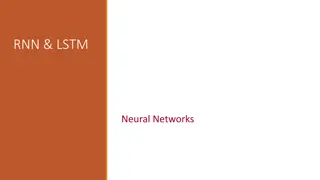The World of Creative Captioning
Every performance is enhanced through the integration of captions, catering to a diverse audience, including those with hearing loss. Explore the history, present impact, and future innovations of creative captioning in various forms of entertainment and communication. Learn about its benefits for actors, audience comfort, and multilingual accessibility, shaping a more inclusive and engaging experience for all.
Download Presentation

Please find below an Image/Link to download the presentation.
The content on the website is provided AS IS for your information and personal use only. It may not be sold, licensed, or shared on other websites without obtaining consent from the author.If you encounter any issues during the download, it is possible that the publisher has removed the file from their server.
You are allowed to download the files provided on this website for personal or commercial use, subject to the condition that they are used lawfully. All files are the property of their respective owners.
The content on the website is provided AS IS for your information and personal use only. It may not be sold, licensed, or shared on other websites without obtaining consent from the author.
E N D
Presentation Transcript
PILOT ANALYSIS OF THE CONTEMPORARY BELIEFS AND IDENTITY INVENTORY Kathleen Moser, Shelby Kreglow, Stevie N. Grassetti, Ph.D., & Caroline Guzi, M.A.
What is feminism? Feminism is a social movement that advocates for the protection and implementation of policies that promote gender equality. Art by Justin Tran
Why measure feminism in people who do not identify as women? Why create a new measure? Gender roles in feminism What measures are being used now?
Why measure feminism in people who do not identify as women? Traditionally, feminism has revolved around the rights and beliefs of women. Measures of feminism tend to focus on women s beliefs about gender rights, gender roles, and gender equality without asking for the input of men. This excludes fifty percent of the population; this fifty percent is likely responsible for deficits in gender equality. 1 The support of people who do not identify as women is imperative to advancing feminist ideals. 2 Another study, in Sweden, found that men s roles in feminism differ based on location and context. 3 Because men s opinions are so pertinent, yet variable, their beliefs must be collected to allow for a comprehensive plan for gender equality 1 Ritchie & Roser 2019, 2 Precopio & Ramsey 2017, 3 Holmgren & Hearn 2009
Why create a new measure? While many non-women may support feminist views, measures of feminist identity typically focus exclusively on the views of women. 4 This deficit in data conveys a lack of interest in men and non-binary individuals, which exemplifies those beliefs that cause gender-based prejudice and discrimination. Example: I enjoy the pride and self-assurance that comes from being a strong female. 5 Furthermore, current measures are outdated, characterizing the needs of people from decades ago. Commonly used measures: Feminism Identity Composite 5, Feminism Scale 6, and Feminist Perspective Scale 7 Example: The breakdown of the traditional family structure is responsible for the evils in our society. 7 4 Wiley et al. 2012, 5 Fischer et. al 2000, 6 Dempewolff 1974, 7 Henley et. al 1998
Current Measures of Feminism Feminism Identity Composite 3 Feminism Scale 4 Feminist Perspective Scale 5 33-item likert-style scale designed to measure feminism identity development in women. Not normed for men or non- binary gender groups. Used to assess validity of measure with all genders. 28-item likert-style scale which measures feminism identity. 78-item likert-style scale developed to measure attitudes toward feminism through a multipronged approach. Addresses feminism, socio- political stance, and African American rights in conjunction with gender roles Used to test the longevity of feminist goals and attitudes Used to test effectiveness of older style of feminism measures on contemporary views of feminism 5 Fischer et. al 2000, 6 Dempewolff 1974, 7 Henley et. al 1998
Purpose of the study There is a need for updated measures of feminist views that are inclusive to all genders. The purpose of this study was to test the psychometric properties of The Contemporary Beliefs and Identity Inventory a new, gender-inclusive feminist identity measure. This measure is designed to be administered to people of all genders in contrast to traditional feminism research which focuses solely on women s perspectives.
Participants N = 340 undergraduate students volunteered to participate in this study for Intro to Psychology course credit. Gender. 66.4% participants identify as female, 32.5% identify as men, and .4% identify as other. Two participants chose not to respond. Race/Ethnicity. Participants identified (in non-exclusive categories) as 74.5% Caucasian, 10% African, 7% mixed, 4.4% other, 4.1% Latinx, 3.7% Asian, 1.8% Middle Eastern, and 1.8% Caribbean.
Participants completed the 20-item Contemporary Beliefs and Identity Inventory online via Qualtrics as a part of a larger study. Feminism scores are based on participants agreement on 20-item likert-style questionnaire. Methods An exploratory factor analysis (Principle axis factoring with varimax rotation and eigen value of 1) suggested three subfactors 1. General gender rights and equality 2. Women s autonomy 3. Gender roles in the family
Results n= 69 participants were excluded due to failing a validity item, which resulted in a sample of 271 for preliminary psychometric analyses. Three subfactors established: 1. General gender rights and equality 2. Women s autonomy 3. Gender roles in the family The full 20-item scale had strong internal consistency (Cronbach s a= .91). One-item factor removed Deletion of items that loaded below a = 0.45 Four factors accounted for 58.27% of variance
Factor 1. General gender rights and equality (a= .87) 10. Legal documents should allow for alternative gender options besides male and female. (.78) 3. One should be permitted to use the bathroom that they feel matches their gender identity. (.77) 20. People should have the right to go by their pronoun of choice. (.69) 7. It is the responsibility of all people to advocate for gender rights. (.60) 19. Feminism is the only way to obtain gender equality. (.59) 18. Traditional gender practices can be demoralizing and limit a person s personal growth. (.58) 8. Men, women, transgender, and gender-fluid individuals should all enjoy the same rights and opportunities. (.54) 13. Transgender people should have the right to be involved in combat sports. (.51) The Items Factor 1. General gender rights and equality Characterize general beliefs about equality amongst various genders. Include concerns about the inclusivity of traditional feminist ideals.
Factor 2. Womens autonomy (a=.69) 14. It is as acceptable for a woman to drink alcohol as it is for a man to drink alcohol. (.68) The Items 12. A person s gender should not impact their right to enter legal agreements. (.55) Factor 2. Women s autonomy 9. A woman should be able to do what she would like with her body, law permitting, without the input of a man. (.46) Indicate a need for women to take charge of their own bodies. Obtain contemporary opinions on traditional gender role concerns.
Factor 3. Gender roles in the family (a=.58) 11. It is a man s responsibility to provide for himself and his family. (.59) 1. Women should be the main caretakers of children (.56) 2. No one should be exempt from a draft due to gender. (.50) The Items Factor 3. Gender roles in the family Measure opinions of equality within the home. These items reflect traditional gender roles established within a family.
Excluded Items: 4. The primary caregiver for a child should be distributed equally amongst parents, regardless of gender. 5. If a woman and a man have the same credentials and do the same work, they should be paid the same. 6. Companies should have the right to deny someone services based on that person s gender identity; 15. There is a difference between biological sex and gender identity. 16. The genders are not equal; thus feminism is an unhelpful movement. 17. A person s gender and marital status should not impact their right to raise a child. The Items These items were deleted for various reasons: 1. Subfactor was too small to be considered significant 2. Alpha coefficient loaded below a 0.45.
By establishing factors, we see a significant relationship between various aspects of feminism, implying a relationship between these items and the overarching construct. This study was the first step in the process of shifting to an inclusive perspective of feminism, especially in research. Further testing and implementation is needed for the restructuring of feminism constructs to allow for the rights of all people including female, male, nonbinary, and trans folks. Implications References























